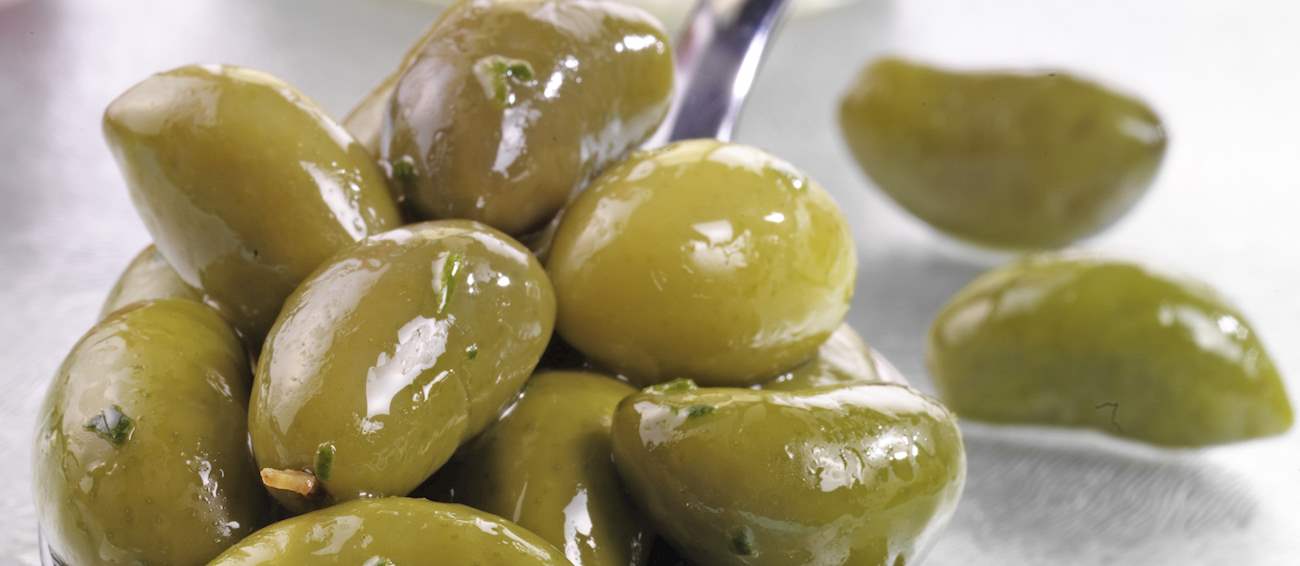Best French Olives Types
Olive de Nice are olive products of the Cailletier variety coming from the French region of Alpes-Maritimes. The product refers to small, meaty olives and olive paste. The olives have a firm texture, a smell reminiscent of dried fruit and a slightly bitter taste.
The flesh is delicate and must come away easily from the pits while their color is yellow-green to brown and dark blue to black. The olive paste, on the other hand, has a smooth, fine texture with a smell compared to that of olive oil, and has a wine color, neither green nor too dark.
Lucques du Languedoc are green olives originating from Italy and grown and harvested in the Languedoc area in the south of France. They are harvested in the fall, green and unripe because the trees bear fruit early and ripen much later.
The olives are de-bittered and fermented in brine and refrigerated for at least one month. They have the shape of an almond, elongated and asymmetric. Their color is bright green, similar to that of avocados. Its taste is buttery, nutty, somewhat sweet, similar to that of avocados or almonds.
The texture is crisp, meaty and fresh and while the olives can also be used to extract the oil of excellent quality, it is a pretty difficult process which gives a medium oil yield.
Olive de Nîmes are whole green olives of the Picholine variety, with a characteristically crunchy and juicy texture. They are produced in the Gard and Hérault regions in France, where the olive trees have been present since ancient times.
Only the olives from the finest, firmest olive trees are suitable for this production process. The olives are hand harvested in early fall and processed in brine to lose their bitterness. They have an intense green color, are firm to the touch and their flavors are salty, sweet, buttery, slightly bitter and acidic with hints of hazelnut.
Olives cassées de la Vallée des Baux de Provence are broken, green olives from the Salonenque or Béruguette varieties that have a low shelf life, and come flavored with fennel. The olives have been produced in the French region of Bouches-du-Rhône since the 18th century.
Since they are an early product and are the first table olives to reach the consumers in October and early November, they are excitedly awaited each year. They are broken mechanically and left to lose their bitterness, washed with water, put in a brine solution and seasoned with fennel seeds, flowers and stalks.
The Tanche variety of olives from Nyon are a specific shade of brown, almost black, and are finely wrinkled. They are hand-picked in November and December and then sorted according to their intended use. Olive oil is produced only from the smallest olives, while the bigger ones can be eaten on their own, as appetisers or used in salads or omelettes.
The olives have a mildly salty and pleasantly bitter taste. They are commonly dry-cured in salt, to pull the moisture and bitterness out of them, and packed in olive oil. Olives noires de Nyons pair nicely with cheese, almonds, onions and a variety of spices.
Olives noires de la Vallée des Baux de Provence are dark olives of the Grossane variety grown exclusively in the French region of Bouches-du-Rhône. They have a tasty, chunky flesh and are plump and short, with a wide base.
If they get pressed in order to produce olive oil, the oil possesses aromas reminiscent of fresh grapefruit and tomatoes. They reach the consumers' table in December, which is why they hold the nickname Christmas olives, providing an additional source of income for the farmers during the winter season.
TasteAtlas food rankings are based on the ratings of the TasteAtlas audience, with a series of mechanisms that recognize real users and that ignore bot, nationalist or local patriotic ratings, and give additional value to the ratings of users that the system recognizes as knowledgeable. TasteAtlas Rankings should not be seen as the final global conclusion about food. Their purpose is to promote excellent local foods, instill pride in traditional dishes, and arouse curiosity about dishes you haven’t tried.



